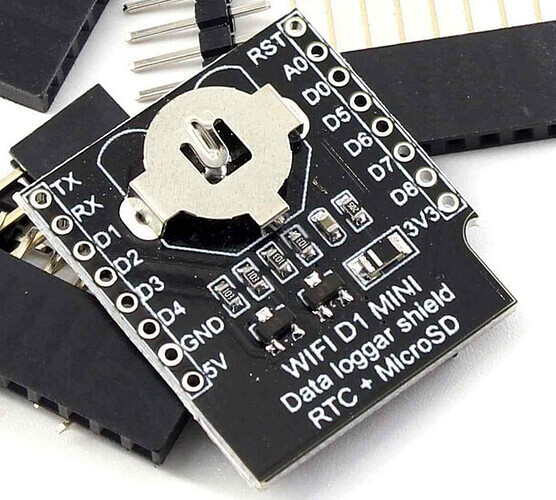🧭 Instructional WordPress Page
WiFi D1 Mini Data Logger Shield — RTC and MicroSD Explained
If you’re diving into IoT or sensor logging projects with the Wemos D1 Mini, the Data Logger Shield with an RTC (Real-Time Clock) and MicroSD slot is one of the most useful add-ons you can use. It lets your ESP8266 board keep accurate time and store readings even when your Wi-Fi is down.

1. What This Shield Does
The WiFi D1 Mini Data Logger Shield combines two powerful modules:
- DS1307 or DS3231 RTC chip — keeps track of time, even without power.
- MicroSD card interface — stores sensor readings, logs, or events.
Together, these make it perfect for data-logging projects such as weather stations, temperature monitors, or system diagnostics.
2. How It Connects
The shield plugs directly onto the D1 Mini, sharing the same pins:
- I²C bus (SDA → D2, SCL → D1) for the RTC module
- SPI bus (MOSI → D7, MISO → D6, CLK → D5, CS → D8) for the MicroSD card
No soldering required for basic setup — just stack the shield and go.
3. Typical Use Case
You might have a sensor like a BMP180 or DHT22 that reads temperature, humidity, or pressure.
Each reading can be timestamped by the RTC and written to the SD card like this:
2025-10-23, 18:45:00, Temp: 72.5°F, Humidity: 41%
You can later remove the MicroSD card and analyze the data on your computer using Excel or any spreadsheet tool.
4. Libraries You’ll Need
Install the following libraries in the Arduino IDE:
- RTClib — for reading/writing to the RTC
- SD or SdFat — for MicroSD access
- Wire — for I²C communication
Under Tools → Board, select:
LOLIN(WEMOS) D1 R2 & mini
Then, upload your sketch and open the Serial Monitor to see logs in real-time.
5. Quick Tip
If you want continuous data collection even without Wi-Fi, the shield is a great offline backup. Once reconnected, you can upload stored logs to your IoT dashboard or a cloud database.
6. Powering the Setup
The D1 Mini with this shield can be powered via USB 5V or a 3.7V LiPo battery (with a boost converter). Keep in mind the MicroSD needs stable voltage—brownouts can corrupt files.
7. Ideal Projects
- Weather or greenhouse monitors
- Home power usage trackers
- Offline sensor loggers
- Time-stamped event recorders
This little shield turns your compact ESP8266 setup into a self-sufficient data-logging powerhouse!